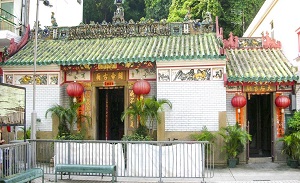Taoism’s Hindu Parallels
 ”From It became One, from One became Two, from Two became Three, from Three became all things in the Universe.” Replace It with Brahman, Siva, Vishnu, or whichever God you believe to be the representation of the Supreme depending on your sampradaya, and you find yourself telling one of the Hindu stories of creation. Replace It with Tao, however, and you find yourself reciting the 42nd verse of the Tao Te Ching, one of the foundational books of the Taoist faith of China.
”From It became One, from One became Two, from Two became Three, from Three became all things in the Universe.” Replace It with Brahman, Siva, Vishnu, or whichever God you believe to be the representation of the Supreme depending on your sampradaya, and you find yourself telling one of the Hindu stories of creation. Replace It with Tao, however, and you find yourself reciting the 42nd verse of the Tao Te Ching, one of the foundational books of the Taoist faith of China.
The similarities do not stop with this one verse. From philosophy to methods of worship to ethics and everything else, there are profound similarities between Hinduism and Taoism, many of which I was blessed to see during a one-day layover in Hong Kong, and in my studies of Chinese culture afterwards. I have found that these similarities are so prevalent that one could claim that Taoism and Hinduism are, in many ways, Indian and Chinese variations of the same faith.
My Revealing Visit to China
The first time I noticed these similarities was in 2019 when I entered a small village in Hong Kong. It was the quaint fishing town of Tai O, from which most of the younger generation had moved out. China is often painted as a second West, incredibly modernized and focused on industrial development; yet, even before we stepped into the village, there was a small red stone murti in a modest shrine just outside.
There isn’t much I can say about it—it was nameless, handless, legless, and merely had a face, with a red hat put on it alongside two stones. What did stand out, however, were the oranges placed alongside it and the red glasses of liquid placed in front of it.
Out of respect for the Deity and not knowing the customs, I did not go closer to it; yet it was clear that He was some sort of Gramadevata for the villagers, given offerings and called upon to protect the village. My curiosity piqued, I took His blessings, so that I could understand the culture of the people in the village better, and how exactly it related to Hindu dharma, if at all. With us were a Hindu couple from Vishakhapatnam whom we had met on the flight going back to their home after visiting their son in California. The resemblance was also clear to them, and they joined me in taking the blessings of the Devata.
Heading into the heart of the village, we came across the 500-year-old Kwan Tai Old Temple. The temple honored Kwan Tai, a general during the Han Dynasty known for his loyalty and righteousness. Much like Hindu mandirs, however, it also contained murtis of other Devatas, such as Tudigong, the God of the Ground and the Soil.
The temple featured a method of divination, something also found in some Hindu temples, though not in this form. Devotees could ask a question, usually regarding marriages and business, and rub two tiles together, throwing them into the air. If both land on the “yes” side, then the answer to the question is yes. While I can’t speak to the accuracy of the method, I did ask the Devatas whether the Chinese Tao and Vedic Brahman are the same. The answer from the tiles was “Yes.”
Similarities in the Two Faiths
After a delicious meal at a local Buddhist monastery, we were on a flight heading home to Los Angeles, where I used the last few days of summer to begin getting an overview of the Taoist beliefs and texts, which until then had been reduced to the popular yin and yang symbol in my mind. I also worked on my Chinese for the next three years, to allow me to better understand the Chinese scriptures and texts. Given the similarities I found between the traditions, it was well worth the effort.
By Rutvij Holay
https://www.hinduismtoday.com/

